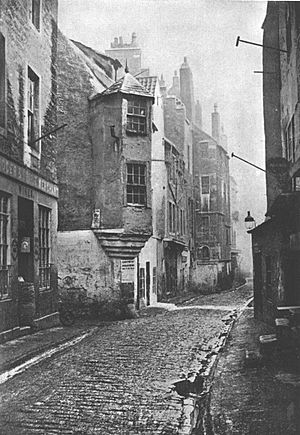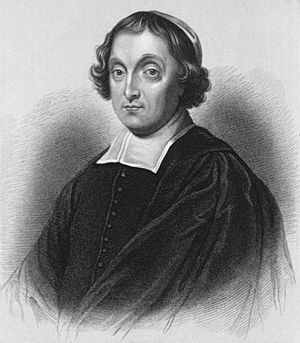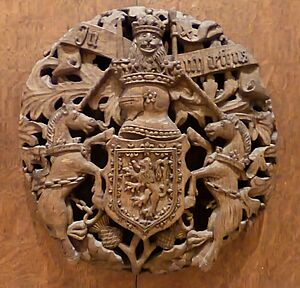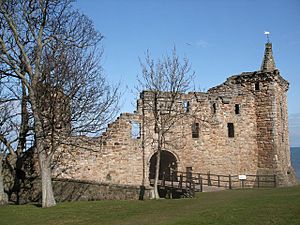David Beaton facts for kids
Quick facts for kids His Eminence David Beaton |
|
|---|---|
| Cardinal Archbishop of St Andrews | |
 |
|
| Archdiocese | St Andrews |
| In Office | 1539–1546 |
| Predecessor | James Beaton |
| Successor | John Hamilton |
| Other posts | Primate of Scotland |
| Orders | |
| Consecration | between 26 July and 13 August 1538 |
| Created Cardinal | 20 December 1538 |
| Rank | Cardinal priest of S. Stefano in Monte Celio |
| Personal details | |
| Born | c. 1494 (probably Balfour), Fife, Scotland |
| Died | 29 May 1546 (aged c. 52) St Andrews Castle, Fife, Scotland |
| Nationality | Scottish |
| Denomination | Roman Catholic Church |
| Parents | John Beaton and Isobel Monypenny |
| Previous post | Coadjutor Archbishop of St Andrews 1537–1539 |
David Beaton (born around 1494, died 29 May 1546) was a very important religious leader in Scotland. He was the Archbishop of St Andrews and the last Scottish Cardinal before the Reformation. This was a time when many people in Scotland changed from being Catholic to Protestant.
Contents
Early Life and Career
David Beaton was the youngest of eleven children. His family, the Bethunes of Balfour, were part of a Scottish noble family called Clan Bethune. He was born around 1494 in Fife, Scotland.
David Beaton went to university in St Andrews and Glasgow. When he was 16, he went to Paris, France, to study law. In 1519, James V of Scotland, the King of Scotland, made him an ambassador to France. This meant he represented Scotland in France.
In 1520, his uncle, James Beaton, who was the Archbishop of Glasgow, gave David a church role in Cambuslang. Later, when his uncle became Archbishop of St Andrews, David took over his uncle's role as Commendator of Arbroath. In 1525, David Beaton returned to Scotland and became a member of the Scottish Parliament. The King also made him Lord Privy Seal in 1528. This was a high-ranking government job.
Between 1533 and 1542, he served as King James V's ambassador to France many times. He played a big part in arranging the King's marriages to Madeleine of France and then to Mary of Guise. In 1537, he became his uncle's helper at St Andrews, meaning he would take over as Archbishop when his uncle left the role.
In December 1537, King Francis I helped David Beaton become a Bishop in France. The next year, in 1538, Pope Paul III made him a Cardinal. In February 1539, Cardinal Beaton became the Archbishop of St Andrews, just as planned. In 1544, he was also made a Papal legate in Scotland. This meant he represented the Pope in Scotland.
Political Views and Conflict
Cardinal Beaton strongly believed in keeping Scotland's alliance with France. He was against any ideas that would make Scotland too close to England. At this time, many people in Scotland were starting to support Protestant ideas. Beaton was against these ideas because he wanted Scotland to remain Catholic.
Relations between King James V of Scotland and his uncle, Henry VIII of England, became difficult. Henry VIII wanted Scotland to break away from the Pope, just as England had done. King James V refused to follow Henry's example. This led to fighting between Scotland and England in 1542. Many people blamed Cardinal Beaton for this war, which ended with Scotland's defeat at the Battle of Solway Moss.
During Mary, Queen of Scots' Reign
King James V died on 14 December 1542, leaving his infant daughter, Mary, Queen of Scots, as the new ruler. Cardinal Beaton tried to become one of the leaders (regents) for the young Queen. He said the late King had left a will naming him as regent. However, most people thought this will was fake. Instead, The 2nd Earl of Arran, who was next in line to the throne, became the regent.
Because of this, Regent Arran had Beaton arrested and imprisoned. The Pope then put a special ban on Scotland, meaning churches were closed and religious services stopped.
With Beaton in prison, the group who wanted Scotland to be closer to England convinced Regent Arran to agree to a marriage treaty with England for Queen Mary. This treaty said Mary would live in England until she was old enough to marry an English prince. Many Scots did not like this idea. They preferred the old alliance with France. This led to Beaton's release from prison. The Scottish Parliament rejected the treaty in December 1543. This started an eight-year conflict with England known as the Rough Wooing. Beaton regained his power in 1543. Many blamed him for the two English invasions that followed.
In December 1545, Cardinal Beaton arranged for the arrest and trial of a Protestant preacher named George Wishart. Wishart was executed on 28 March 1546. Many people supported Wishart, and this event led to the Cardinal's assassination soon after.
Death of Cardinal Beaton
People had been plotting against Cardinal Beaton since 1544. The main plotters were Norman Leslie and William Kirkcaldy of Grange. The Leslies had problems with Beaton's growing power in Fife. Kirkcaldy's uncle, James Kirkcaldy, was a Protestant and had lost his job as treasurer because of Beaton. John Leslie also joined them because he was angry about Wishart's death.
On 29 May 1546, Leslie and Kirkcaldy managed to get into St Andrews Castle early in the morning. They killed the castle guard and then murdered the Cardinal.
Many people at the time believed that King Henry VIII of England wanted Beaton dead. Henry saw Beaton as the main obstacle to his plans for Scotland. The Cardinal's murder was a very important moment in the rise of Protestantism in Scotland.
When he died, David Cardinal Beaton was the Lord Chancellor of Scotland, the Archbishop of St Andrews, and the Pope's representative in Scotland. John Hamilton took over as Archbishop of St Andrews after him.
See also
 In Spanish: David Beaton para niños
In Spanish: David Beaton para niños






